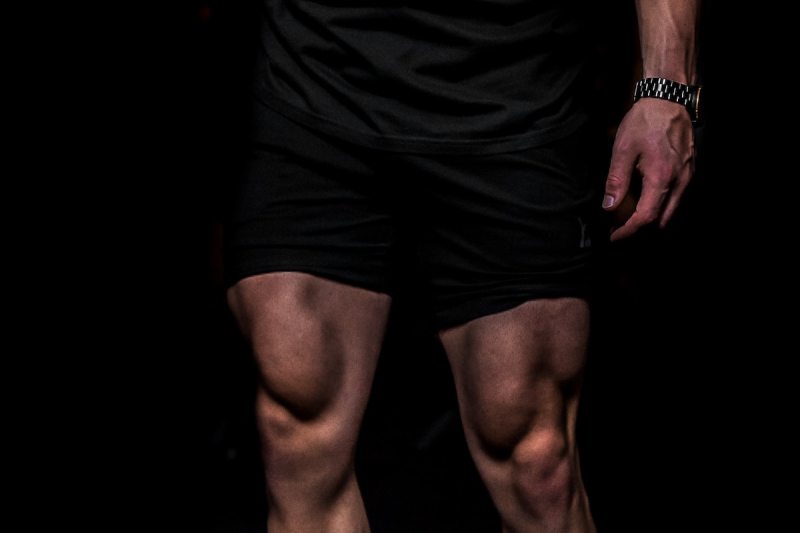
Often overlooked in the weight room community, the legs are the foundation of your physical fitness. The group that stands out most happens to be one of the largest and most powerful muscle groups: the quads. Comprised of four individual muscles (rectus femoris, vastus lateralis, vastus medialis, and vastus intermedius), the quads run down the front of your thighs from your hip to your knee. Your quad muscles are responsible for hip flexion and knee extension, so having strong quads will help you run faster, jump higher, squat heavier, and make you an all-around better athlete.
The best quad exercises for men strengthen one or more of the four quad muscles and condition the quad muscles as a group to handle greater loads and higher forces. Quad exercises may also target the glutes and hamstrings, which work in opposition to the quads, because working these antagonistic muscles builds eccentric (lengthening) strength in the quads.
Fortunately, there are plenty of effective quad exercises and quad workouts that can be done with just a few dumbbells or exercise machines. Check out our detailed guide of the best quad exercises for men and start sculpting that iconic teardrop shape and leg strength you’ve always wanted.
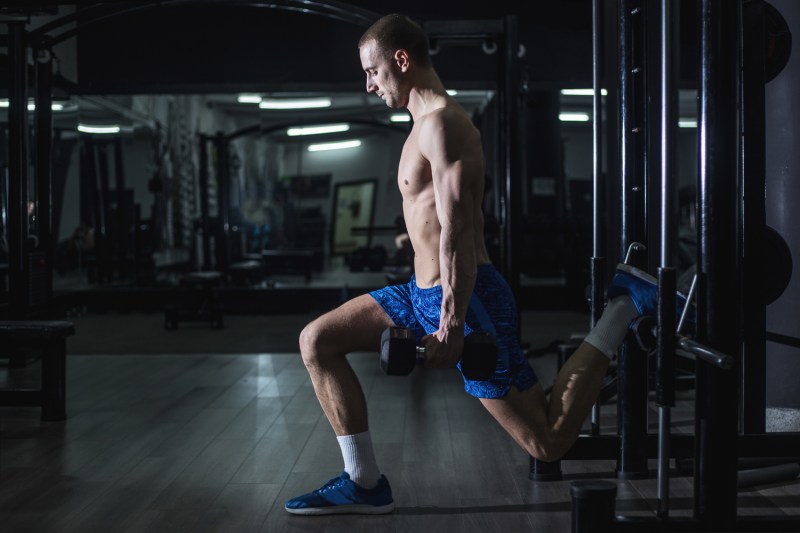
Bulgarian split squat
The Bulgarian split squat is a unilateral exercise, so it requires coordination and balance while also placing a greater demand on your quad muscles.
Equipment needed (optional)
- Medicine balls
- Kettlebells
How to do the Bulgarian split squat
- Stand about 3 feet in front of a bench, facing away, with the top of your rear foot up on the bench behind you. Your front foot should be far enough forward that when you drop into a lunge, your front knee does not extend beyond your toes.
- Hold a pair of dumbbells or kettlebells in each hand. A medicine ball can be held at chest height in place of dumbbells or kettlebells.
- Keeping your shoulders back and core engaged, bend your front knee to drop into a split squat/lunge.
- When the thigh of your front leg is parallel to the ground, press through your heel to return to the standing position.
- Complete 8-10 reps per leg per set.
Tips
- Control the movement on the way down and pause for a half second upon rising back to the starting position.
- When fully rising to the start of each rep, perform a quad contraction, focusing on squeezing the quad to get the most out of the movement.

Pistol squats
Pistol squats are one of the toughest quad exercises because they require tremendous leg strength, core activation, and balance. It’s a great bodyweight exercise, so you can perform this quad exercise at home, but you can also load up with dumbbells as you get stronger.
Equipment needed
None
How to do the pistol squat
- Stand upright with good posture and your feet hip-width apart.
- Lift your left leg and extend it in front of your body.
- Bend your right knee and sit your hips all the way back as you drop down into a single-leg squat.
- Drop as deep as you can while maintaining good form.
- Press through your right heel to stand back up.
- Complete 8-10 reps and then switch sides.
Tips
- This is an advanced movement. To regress the movement try these simple variations. Over time as your strength, ankle flexibility, and coordination improve, progress to the pistol squat.
- Elevated single-leg squat negatives: Perform the pistol squat on an elevated surface like a bench, and use a wall for assistance. Slowly lower into the bottom of a squat, using the wall for balance. Perform 8-10 negatives, slowly lowering yourself with each rep.
- TRX pistol squats: Same steps as the pistol squat plus the addition of TRX straps for additional assistance.

Heel-elevated goblet squats
You can perform goblet squats with your feet planted on the ground, but standing on the dome side of a Bosu ball will further challenge your quads, adductors, and glutes, as well as the smaller muscles that stabilize the ankles and hips.
Equipment needed (optional)
Dumbbells
or
How to do heel-elevated goblet squats
- Stand with your feet hip-width apart, with your heels on an elevated surface such as two 45-pound plates.
- Hold a heavy kettlebell or dumbbell up at chest height (A weight plate is also an acceptable substitute).
- Inhale, bend your knees, and sit your hips backward. Make sure your core is engaged, your chest is up, and your back is straight.
- Exhale, pressing through your heels to return to the starting position.
- Repeat 10-15 reps.
Tips
- The higher the surface you place your heel on during the exercise, the more activation you will get out of the quads
- For maximum quad activation, perform the exercise on a slant board.

Dumbbell step-ups
Strong quads help you climb stairs with minimal effort and charge uphill with speed. Step-ups are a great metabolic conditioning exercise and strengthen the quads along with the glutes, calves, and hamstrings.
Equipment needed
and a box, step, or bench
How to do dumbbell step-ups
- Stand facing a plyometric box, bench, or step that is roughly knee height or slightly lower. Hold a pair of dumbbells in each hand.
- Engage your core and glutes while you step up onto the box with your right foot.
- Step your left leg up onto the box as well.
- Step back down with your right foot first, then your left foot.
- Continue leading with the right foot for 4-5 reps, and then switch sides.
Tips
- Focus on slow, controlled movements while doing the exercise.
- Squeeze the quad at the top of each repetition to get the most out of the quads.
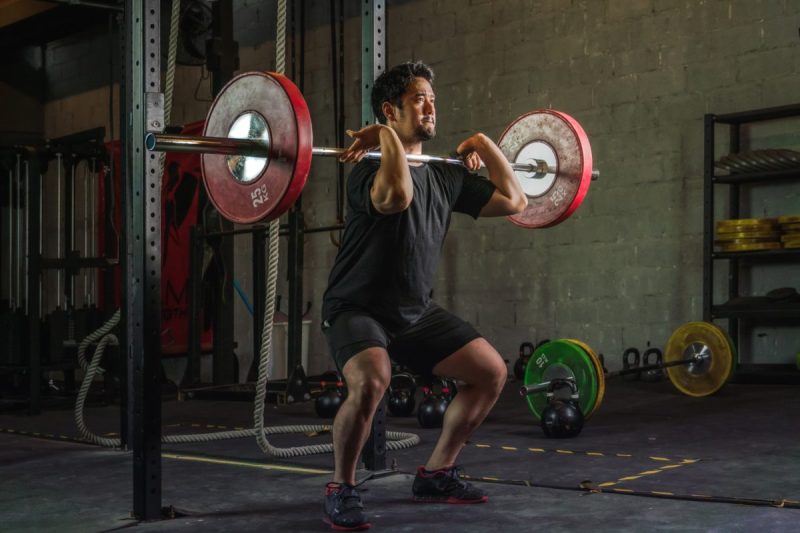
Dumbbell front squats
Squats are certainly the go-to quad exercises for most guys, and for a good reason: they work. There are all sorts of squat variations, but the front squat is one of the best quad exercises and puts less stress on your back than a back squat.
Equipment needed
Dumbbells or barbells
How to do dumbbell front squats
- Stand upright with your feet shoulder-width apart, shoulders back, chest up, and core engaged.
- Hold the barbell or dumbbells around the level of your clavicles.
- Bend your knees and sit your hips all the way back as if reaching your butt back to sit in a chair.
- When your thighs are parallel to the floor, press through your heels to stand back up.
- Complete 6-12 reps.
Tips
- To maximize quad activation: Place heels on an elevated surface, such as a 45-pound plate, during exercise.

Leg press
The leg press machine is a great way to strengthen your quads and build muscle, particularly if you don’t have a spotter. For hypertrophy training (gaining muscle size), use the heaviest weight you can handle for 3-6 reps. To increase strength but not size, use a lighter weight and complete 12-15 reps.
Equipment needed
Leg press machine
How to do a leg press
- Position yourself in the leg press machine so that you’re lying back with your head and back fully supported, your knees bent to 90 degrees, and your feet up on the platform a little wider than shoulder-width apart. Grasp the handles with your hands.
- Push through your heels to extend your legs fully without fully locking out your knees.
- Bend your knees to slowly the weights back down.
Tips
- The leg press is great for being able to prioritize both the hamstrings and glutes depending on foot placement.
- For more quad activation, place feet as low as possible on the base plate of the leg press machine.
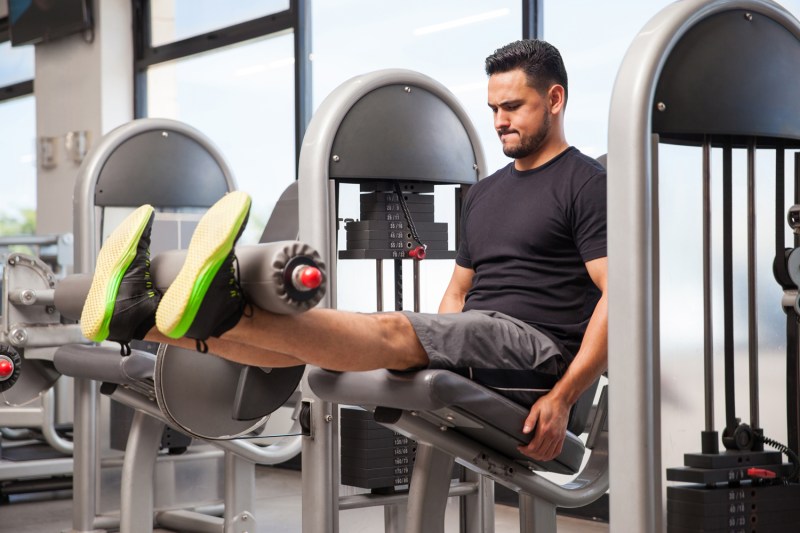
Leg extension
The leg extension machine is one of the best ways to isolate your quads for maximal strengthening. If you don’t have access to a leg press machine, you can replicate the exercise with ankle weights, though the load you can lift will be much less.
Equipment needed
Leg extension machine
How to do a leg extension
- Sit on a leg press machine with your legs under the pads such that the pad is just above your ankles and your knees are bent to 90 degrees. Your back should be flush with the machine. Grasp the hand bars.
- Keeping your back and thighs stationary, exhale while extending your legs fully.
- Pause and then slowly lower the weight.
- Perform 12-15 repetitions per set.
Tips
- The leg extension machine is great for hitting all four muscles of the quads depending on foot placement.
- For optimal recruitment of all: perform one set with toes pointing towards the ceiling, one set with feet duck-toed, and one set with pigeon-toed.

Walking dumbbell lunges
Watch any video of Dwayne “The Rock” Johnson on leg days and he is always doing weighted walking lunges. One of the best ways to completely “burn out” your legs at the end of a session. Need we say more?
Equipment needed
How to do walking dumbbell lunges
- Grab a pair of dumbbells in each hand.
- Start in a tall athletic stance, feet shoulder-width apart.
- Perform a right leg lunge forward, making sure your left knee just taps the ground.
- Rise up, while stepping your left foot forward so you are back in a shoulder-width foot stance
- Continue alternating walking lunges with the right foot first, then the left foot.
- Perform walking lunges for 50 feet.
Tips
- To get an added leg burn, perform an additional bodyweight drop set.
- Immediately upon finishing the set, drop the dumbbells and repeat the set with just your body weight.

Sissy squats
A bygone exercise of the golden era of bodybuilding, think peak Arnold, the sissy squat is anything but for sissies. The same can be said for sissy squats as can be for pistol squats. It is one of the hardest exercises to fully master as it requires tremendous quad and core strength, as well as balance and coordination. Once you get the hang of body weight sissy squats, you can up the ante by adding dumbbells.
Equipment needed
None or dumbbells
How to do sissy squats
- Stand upright with your feet shoulder-width apart on the balls of your feet. Use a prop such as a squat rack for balance until you fully master the balance portion of the movement.
- Begin slowly squatting towards the ground, allowing your knees to shift forward while simultaneously leaning slightly backward with your torso as a counterbalance.
- Slowly continue squatting down toward the ground until your knees touch the floor; heels should remain elevated the entire movement.
- From there, return to an upright position by driving the balls of your feet into the ground, squeezing the quads, almost as if you were pushing backward and up.
- Complete 10 reps.
Tips
- Another advanced bodyweight movement is similar to the pistol squat. Check out this regression if bodyweight is too challenging.
- TRX sissy squat: Similar to the pistol squat, TRX straps can be used to begin to master the strength and movement of this exercise.
- Squat rack assisted sissy squat: Perform the exercise facing a squat rack and hold onto the pole of the rack. Perform the movement and use the rack to help pull yourself upwards.
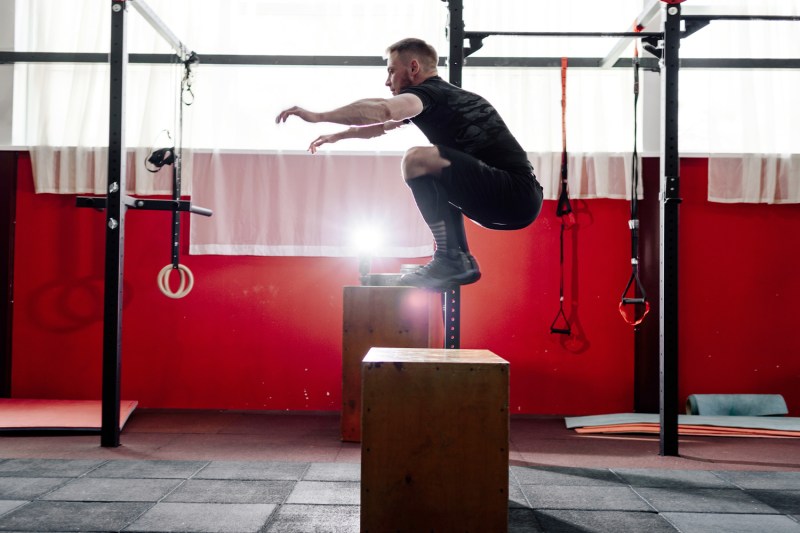
Box jumps
Box jumps are a challenging plyometric exercise. This total-body move builds power and strength in your quads, glutes, calves, and hamstrings. As you get stronger, use taller boxes to progress the difficulty.
Equipment needed
Plyometric box, bench, or step
How to do box jumps
- Stand facing the box or step with your feet slightly wider than shoulder-width apart, core engaged, and arms at your side.
- Bend your knees to drop into a squat, sitting your hips back. Then, press through your heels while using your arms to powerfully explode upward to jump onto the box.
- Use your arms and quads to absorb the forces of landing.
- Jump backward back down.
- Complete 10 reps.
Tips
- To challenge explosive power, try this additional challenge.
- Place a bench 6-12 inches in front of the box.
- While facing the bench, perform a box jump from the start of a bench-seated position.

Why are strong quads important?
As you can see, there are many ways to strengthen your quads, and doing that will help make you a better athlete, but there are more benefits to having strong quad muscles, ones that will help in everyday life, not just in the workout room.
The benefits of strong quads
- Better shock absorption when you land on your feet since the quads help stabilize your knees.
- Strong quads help ease the pressure on your knees, which can help prevent injury and general pain, especially as you get older.
- Aids in keeping good posture and balance.
- Helps prevent osteoarthritis in the knees.
Editors' Recommendations
- Working out on keto: Maximize your fitness plan with this handy guide
- How to do a goblet squat: Your complete guide
- How to do a leg press: Everything you need to know
- Sound therapy to improve your workouts: does it really work?
- Anyone can do Chris Hemsworth’s 15-minute resistance band workout



